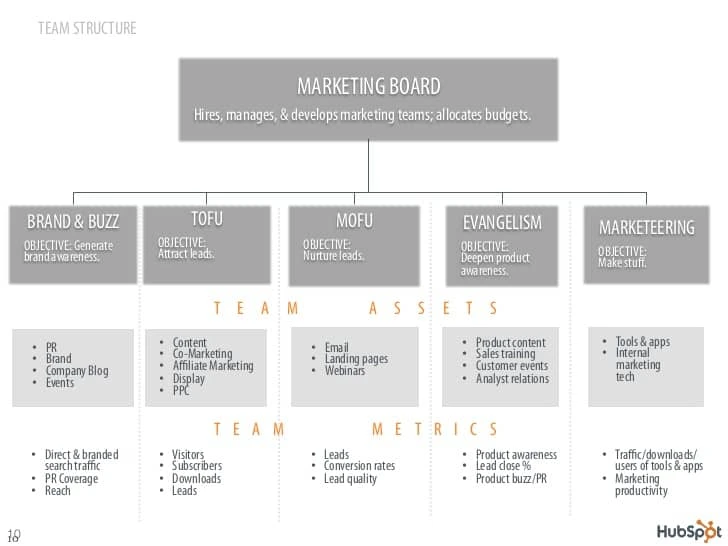There are many setups an agile marketing team can work in – and one of them is an entirely in-house team. Although probably “one” is also not the right word – as practice shows, an in-house agile marketing team can be structured in many ways, too. Let’s look at what some of the options are.
The challenges of running an in-house agile marketing team
First, let’s remember that an in-house agile marketing team will be slightly different from a typical in-house software development team most of us are used to. And not just because marketers have come up with a separate agile manifesto.
While software developers usually specialize in specific technologies and programming languages, marketers are used to a more varied scope of responsibilities and often unlikely to focus on the process alone and entirely forgo execution.
Some marketing teams choose not to outsource any part of the marketing processes, though, whether it’s planning or execution. This might be because of past negative experiences with external agencies, budget shortages, or because they’re focusing on building competencies within an internal team.
Whatever the reason, this comes with its own set of challenges, additionally depending on whether you’re building an entirely new team or introducing agile into your existing one.
- The size. On the one hand, it’s easier to go fully agile with a smaller marketing team and a flat structure. The bigger a team gets, and the more complicated the hierarchy within a team, the more difficult agility – and collaboration itself – will become.
Complex marketing teams with subteams led by their own managers or heads are often prone to creating silos, virtually the opposite of agility.
It’s easy to imagine a team with a Content Marketing Director and their team, Head of Social Media, Head of Paid Campaigns/Performance Marketing, Product Marketing Lead, and so on. Introducing agile marketing will require a lot of understanding and flexibility, plus the leadership’s willingness to abandon traditional managerial roles and take on new ones that promote agility (more on that later.)
-
The scale. Closely tied to the size. A small team can be self-reliant only up to a point. The challenge comes with things like producing enough marketing content or running extensive paid campaigns internally, without outsourcing them to external agencies or contractors and scaling the team. And when you scale it, you need solid agile processes instead to avoid the trap of siloed marketing.
-
The skills (and hiring). Building a full-stack agile marketing team is not an easy task, given that you’re going to need various skills complementing each other to account for both the strategy and execution. It’s easy to fall into the trap of executing only, with no time to take a step back and strategize.
Another challenge comes with hiring agile marketers, as it’s not easy to come by experts who are proactive, flexible, creative, and responsible all at once. And any hiring mistake might result in a dysfunctional agile team.
- Embracing change. Small marketing teams are often agile by nature. So introducing agile processes might be a natural next step that’s easy for everyone to accept and take an active part in (which is a necessary prerequisite if this is going to work).
But when you have a larger and more complex team, you might encounter a natural resistance to change, with people used to their job titles and descriptions, which agile often disrupts. Changing job titles is usually a good start, but there’s much more work ahead.
The benefits of agile marketing organized in-house
With all of the challenges, keeping an agile marketing team entirely in-house is not an easy task. But it doesn’t come without its benefits.
-
**There’s stronger ownership,**as is usually the case with in-house teams.And it’s typically easier to execute it.
-
Streamlined communication. The team is closer to other departments and the product, which (at least that was the case in pre-COVID times) makes the communication flow easier – both within the team and with other departments – given that the team is physically in the same office.
-
Shorter and transparent decision-making process. Not working with external stakeholders or executive teams might help expedite decision-making (although a lot depends on the team’s internal setup and ownership).
-
Easier focus on the customer. Marketing teams, in general, are (or at least should be) mostly customer-driven. Being closer to the product and internal customer research makes it easier to identify with the target group and get access to insights into it, including their pains and problems, which should be addressed in the marketing communication.
-
Better planning. This comes as a given, with more comfort for both the marketing team and other teams in expecting campaign launches or content at certain times and aligning them with other internal processes, like the product roadmap.
This is especially useful if other teams – like product development – are already agile (which also usually makes introducing agile methodologies within the marketing team easier.)
Structuring an agile marketing team
Traditionally, agile teams are cross-functional, which leads to naturally self-organizing teams based on the skills needed for a project. The challenge with agile marketing teams is that there are likely to be specialists in narrow marketing fields like SEO or paid campaigns. At the same time, more and more often, you’ll also have the so-called T-shaped marketers, with more in-depth knowledge in one or several marketing areas and a general understanding of others.
So, a lot of the time, how you structure the in-house agile marketing team will be specific to your organization.
Leadership roles
-
Agile Team Lead. A person to help the team meet its objectives, including getting stuff done.
-
Marketing Owner. Like the Product Owner role for agile product development, they connect the marketing team with stakeholders on other teams, like sales or product. Their part is to make sure projects are happening on time, and the team can work without interruptions.
-
Agile Marketing Director/Manager/VP. In agile methodology, they usually keep their traditional strategic role and are also more involved in what the team is doing, becoming a facilitator.
-
Agile Marketing Coach. Someone who’s supporting teams transitioning to agile roles and participating in the daily standup meetings.
Execution team
An in-house agile marketing team requires a robust marketing stack, which means it will likely benefit from both the generalists and specialists, depending on the projects. And most likely, it’s going to heavily rely on multi-skilled members who can take on many hats. The challenge is to combine all the necessary skills for a truly self-reliant team that won’t need external support in both planning and execution.
Some experts recommend an optimum of 5 people in a team. Others, like Scott Brinker, the author of “Hacking Marketing”, recommend a maximum of 10 to 12 team members, with an extra layer of leadership needed for larger teams.
There are two main types of execution teams suitable for different agile frameworks (Kanban vs. Scrum).
- Support teamsare made up of experts in one field supporting certain areas or teams (their internal clients) within the organization. An example could be a content marketing team creating content for different teams within the marketing department (like SEO, lead generation, or retention) and other teams like sales.
Typically, they’re better off using Kanban to deal with the incoming requests, which are usually answered chronologically.

An example of a support team serving other teams within the marketing department and across the organization.
-
Cross-functional teamscan work on an entire campaign from start to finish, and so are perfect for Scrum. An example setup can be:
-
a marketing strategist
-
graphic designer
-
copywriter
-
content marketer
-
SEO expert
-
web developer
-
PPC expert
-
and anyone else needed to deliver the entire project without resorting to external teams or contractors.

Examples of cross-functional teams based on stages of the sales funnel in HubSpot’s agile marketing team. Source: HubSpot
The roles within the execution team will depend on the blend of skills within it and whether you have generalists, specialists, or T-shaped marketers, with the latter being more flexible to adjust roles as needed in a cross-functional team.
Femi Olajiga, the author of “Lean-Agile Marketing,” admits there’s no silver bullet when it comes to an agile marketing team structure and recommends asking yourself a few questions first:
-
How can you create an environment of trust and respect?
-
How can you create a culture of continuous improvement?
-
What needs to change in your current setup? What problems are you facing?
-
How will you manage task dependencies within teams?
-
How do you eliminate silos?
What he also suggests is the continuous improvement and optimization of the structure of an in-house agile marketing team – just like any other aspect of its activity.
With smaller teams, you might be, sooner or later, looking to external teams or contractors for help with tasks like content creation, which gets difficult to manage with a small team when your needs – and your customer base – grow.
But whatever the size, and regardless of whether you’re outsourcing or not, you will need to rely on software tools to aid and streamline collaboration in agile marketing projects. Luckily, there are multiple apps that help manage sprints, communicate daily, and run agile ceremonies online when offline meetings are out of the picture.
